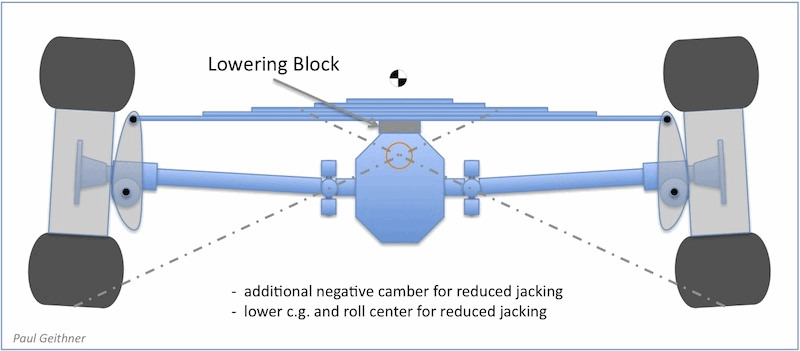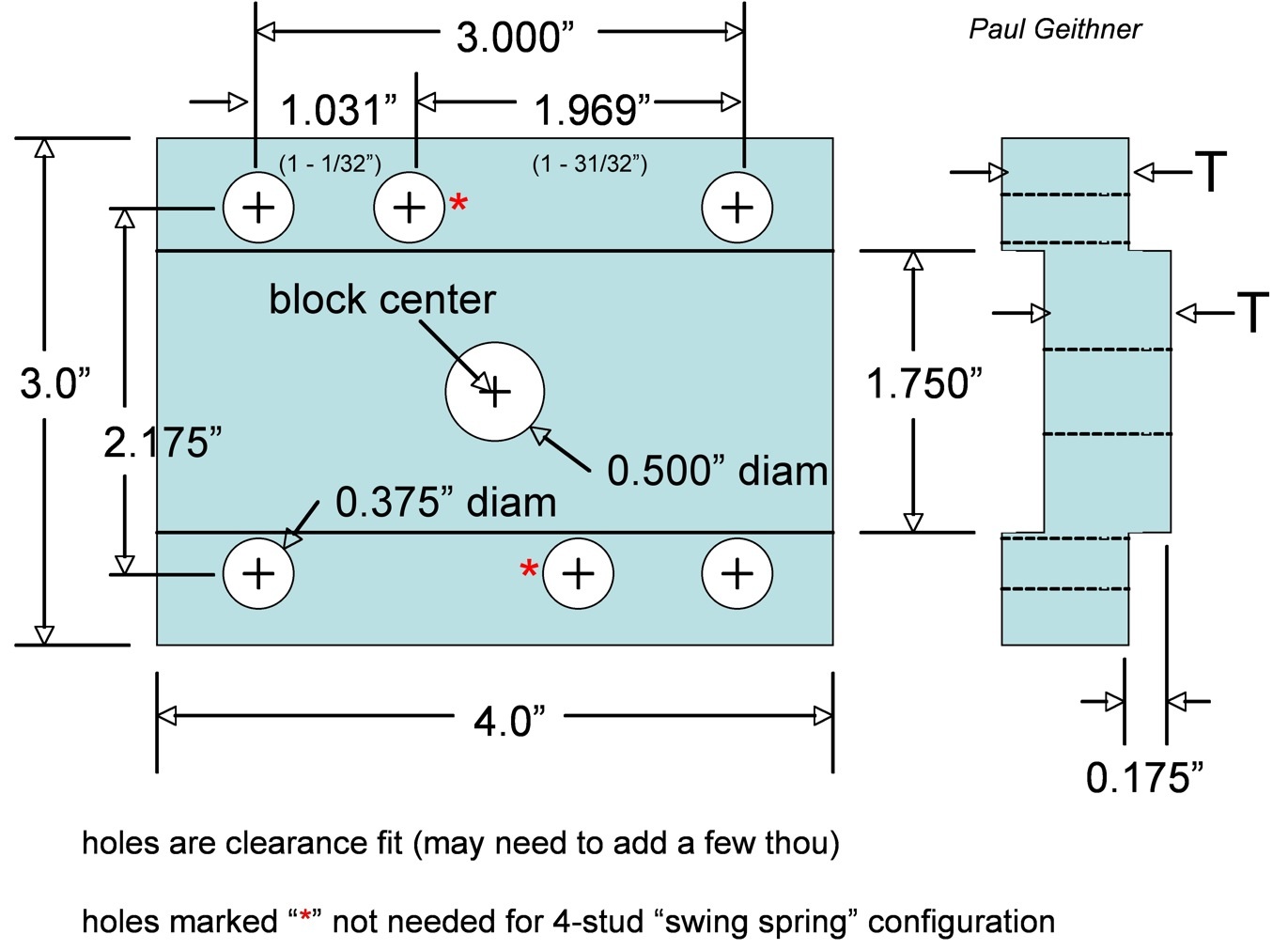
 From Paul
Geithner's Triumph Spitfire
From Paul
Geithner's Triumph Spitfire
Links, References
& Technical Information
Spitfire and
GT6 Rear Suspension Lowering Block
Camber of swing axles is solely determined by the height of the differential relative to the hubs and the length of the swing axles. Because the differential is sprung mass attached to the chassis, this means rear camber of a given set of swing axles is determined by rear ride height. Lowering the rear generates negative camber; raising the rear generates positive camber. Initial negative camber on swing axles helps handling two ways. First, it lowers both the roll center and the center of gravity (c.g.) of the vehicle, which reduces jacking during braking and turning. Second, it "pronates" the swing axles, angling them so the ends at the differential are lower than the ends at the wheels, which means that during a turn, the rear of the car has to rise and roll more before the angle of the outboard wheel assumes positive camber and the outside swing axle points up toward the differential to add even more jacking force.
How to Lower the Spitfire or GT6 Rear?
The simplest, most straightforward and deterministic way to lower the rear of the swing axle Spitfires and GT6s to increase negative camber is to use a shim in between the differential and the transverse leaf spring. Since the differential is attached to the chassis and is located below the transverse leaf spring, a Spitfire or GT6 rear literally hangs from its transverse leaf spring, and so adding a shim (a.k.a. "lowering block") between the spring and the differential lowers the rear of the car.

While some initial negative rear camber is good, too much prohibits formation of good tire contact (especially with wider, lower-profile tires), reduces tracking stability, degrades braking and causes uneven tire wear. Experience suggests that compromising at 3 to 4 degrees initial/static negative rear camber is good for the sporty street Spitfire. The lower rear roll center and c.g. and added negative camber results in quite noticeable handling improvement--reduced jacking with no light feeling from the rear, and reduced roll during cornering--and more driving confidence and enjoyment.

Here's
a calculation for estimating the thickness of lowering block
needed to
go from an initial camber setting to a more negative one:
target block thickness "T" = effective axle length * sin(initial camber - target camber)
because for small angles, sin(theta) = theta, this can be approximated to:
T = effective axle length * [180 * (initial camber - target camber) / 3.14]
where initial and target camber are in degrees. Note that block thickness means net thickness--i.e., the thickness of the middle portion that goes between the bottom of the spring and the top of the differential. This simple formula is valid for the small angles of only a few degrees being dealt with here. Effective axle length is the distance from the swing axle u-joint to the bolt that attaches the swing axle trunnion to the vertical link. In the case of the "long" later model swing axles (used on later mkIV Spitfires--FH50001 and up starting in February 1973--and all 1500 Spitfires), this measurement is 16 inches, and for the shorter swing axles used on earlier cars it's 15 inches. This small difference in axle length makes a small difference in the calculation and the actual results. Roughly speaking, each 1/4 inch of block thickness generates nearly one degree of negative camber change, as shown in the plot below:

For
example, if you are starting with -1 degrees and you
want to achieve -4 degrees, that's a -3 degree change and so a 3/4 inch
block will do. Knowing that 1/4
inch of block thickness generates nearly one degree of negative camber
change is
handy because commercially-available lowering blocks come in 1/2, 3/4
and 1 inch thicknesses, corresponding to almost 2, 3 and 4 degrees of
negative
camber change, respectively. You can zero in on other change
values if you machine your own block. Be
aware
that the use of any lowering block thicker than 0.5 inches net will
necessitate using longer studs to attach the transverse leaf spring to
the differential, which in turn may require modification of the
spring/differential access cover to provide clearance for the longer studs.